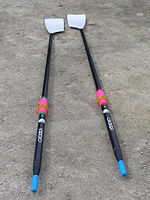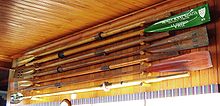- Oar
-
This article is about the instrument used in aquatic travel. For other uses, see OAR (disambiguation).
An oar is an implement used for water-borne propulsion. Oars have a flat blade at one end. Oarsmen grasp the oar at the other end. The difference between oars and paddles are that paddles are held by the paddler, and are not connected with the vessel. Oars generally are connected to the vessel by means of rowlocks or tholes which transmit the applied force to the boat. In this system (known as a second class lever) the water is the fulcrum.
Oarsmen generally face the stern of the vessel, reach as far as they can towards the stern, and insert the blade of their oar in the water. As they lean back, towards the vessel's bow, the blade of their oars sweeps the water towards the stern, providing forward thrust - see lever.
For thousands of years vessels were powered either by sails, or the mechanical work of oarsmen, or paddlers. Some ancient vessels were propelled by either oars or sail, depending on the speed and direction of the wind (see galley).
Contents
Construction
Oars have traditionally been made of wood. The form is a long shaft (or loom) with a flat blade on the end. Where the oar connects to the boat there is a "collar" which stops the oar slipping past the rowlock. Oars usually have a handle, which may be a material sleeve or alternatively a shape carved to fit the hands.
Oars used for transportation
The oars used for transportation come in a variety of sizes. The oars used in small dinghies or rafts can be less than 2 metres long. In classical times warships were propelled by very long oars that might have several oarsmen per oar. These oars could be more than a dozen metres long.
Oars used for competitive rowing
Main article: Oar (sport rowing) A set of Croker sculling oars used for the sport of rowing
A set of Croker sculling oars used for the sport of rowing Trophy oars of the seven founding member clubs of the Remenham Club
Trophy oars of the seven founding member clubs of the Remenham Club
The oars used in competitive rowing are long (250–300 cm) poles with one flat end about 50 cm long and 25 cm wide, called the blade. The part of the oar the oarsman holds while rowing is called the handle. While rowing, the oars are supported by metal frames attached to the side of the boat called outriggers. Classic oars were made of wood, but modern oars are made from synthetic material, the most common being carbon fibre.
Oars used as trophies
The sport of competitive rowing has developed a peculiar tradition of using an oar as a memento of significant race wins. A 'trophy oar' is not presented at the end of the race as a more familiar precious metal cup might be, but rather given by the club, school or university that the winning crew or rower represented.
A trophy oar is a competition oar that has been painted in the club colours and has then had the details of the race signwritten on the face of the blade. The most common format would have the coat of arms or crest of the club or school positioned in the centre, with the crew names and the race details arranged around this.
Many older universities (Oxford and Cambridge would be prime examples) and their colleges have long histories of using the trophy oar and many examples are on display in club houses around the world.
In culture
The Norwegian municipalities of Fedje and Herøy have oars in their coat-of-arms.
Oars have been used to describe various animals with characteristics that closely resemble the said rowing implement. The members of the Family Regalecidae, elongated deep-sea fishes, are called oarfish because their body shape is similar to that of an oar.[citation needed] The hawksbill turtle's genus of Eretmochelys is derived from the Latin root eretmo, which roughly translates to oar. The turtle was so-named because of the oar-like shape of its front flippers.[1]
References
- ^ Beltz, Ellin. [http://ebeltz.net/herps/etymain.html#Turtles "Translations and Original Descriptions: Turtles"]. Scientific and Common Names of the Reptiles and Amphibians of North America - Explained. ebeltz.net. http://ebeltz.net/herps/etymain.html#Turtles. Retrieved 2007-02-06.
See also
Categories:- Water sports equipment
- Rowing
- Marine propulsion
Wikimedia Foundation. 2010.


